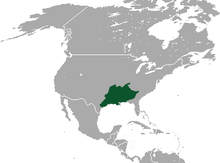Bog rabbit
| Bog rabbit | ||||||||||||
|---|---|---|---|---|---|---|---|---|---|---|---|---|

Marsh rabbit ( Sylvilagus aquaticus ) |
||||||||||||
| Systematics | ||||||||||||
|
||||||||||||
| Scientific name | ||||||||||||
| Sylvilagus aquaticus | ||||||||||||
| ( Bachman , 1837) |
The swamp rabbit ( Sylvilagus aquaticus ) is the largest species of cottontail rabbit ( Sylvilagus ) and is in the marshes and wetlands of the southern United States , from eastern Texas and Kansas to South Carolina , widespread. It is a good swimmer.
features
The marsh rabbit is a typical representative of the cottontail rabbit in its appearance and is similar to the other species of this genus. However, it is one of the largest representatives and reaches a weight of 1.6 to 2.7 kilograms in both sexes, a head-trunk length of 45 to 55 cm with a tail length of 50 to 74 mm. Its ears are relatively small. The head, torso and the top of the tail are rust-brown to blackish, the throat, belly and underside of the tail are white. The paws are lighter, often also reddish. There is a cinnamon-colored ring around the eyes.
Way of life
Marsh rabbits feed on various plants that grow in their habitat. Above all, this includes a wide variety of grasses and reeds . Unlike other cottontail rabbits, they are territorial . The males defend their territory with calls and scent markings that they emit with their kin gland. Swamp rabbits create nests above ground in small structures made of dead plant material and pad them with plucked fur.
The animals are very good swimmers and very often cross streams, ponds and rivers. To hide from their enemies, they often sit in shallow water with only their noses sticking out to breathe. During the day, during the greatest heat, they rest on tree stumps, in low forked branches and on raised patches of grass in the marshland.
Systematics

The swamp rabbit is assigned to the cottontail rabbit (genus Sylvilagus ) as an independent species . It was first described scientifically in 1837 as Lepus aquaticus by the American natural scientist and priest John Bachman .
Hazard and protection
The marsh rabbit is classified by the International Union for Conservation of Nature and Natural Resources (IUCN) as not endangered (least concern) due to the size of the population and the large distribution area. A decline in populations and an endangerment are not known.
Others
In 1979, the American media made a subject of a swamp rabbit that had tried to swim to the small boat of then US President Jimmy Carter . Carter was on a fishing trip when a startled swamp rabbit swam towards his boat. He splashed water on the rabbit with a paddle to drive it away. The press gave the rabbit the title "Killer Rabbit" in reference to the violent rabbit in the film The Knights of the Coconut .
supporting documents
- ↑ a b Sylvilagus aquaticus in the endangered Red List species the IUCN 2006. Posted by: Lagomorph Specialist Group, 1996. Retrieved on 12 May, 2006.
- ↑ Don E. Wilson & DeeAnn M. Reeder (eds.): Sylvilagus aquaticus ( Memento of the original from December 23, 2016 in the Internet Archive ) Info: The archive link was automatically inserted and not yet checked. Please check the original and archive link according to the instructions and then remove this notice. in Mammal Species of the World. A Taxonomic and Geographic Reference (3rd ed).
- ^ John Bachman : Observations on the different species of hares (genus Lepus) inhabiting the United States and Canada. Journal of the Academy of Natural Sciences of Philadelphia 7, 1837; Pp. 282-361. ( Digitized version )
literature
- Ronald W. Kays & Don E. Wilson: Mammals of North America. Princeton University Press, ISBN 978-0691-14092- 6.
- Joseph A. Chapman, Gerardo Ceballos : The Cottontails. In: Joseph A. Chapman, John EC Flux (Eds.): Rabbits, Hares and Pikas. Status Survey and Conservation Action Plan. (PDF file; 11.3 MB) International Union for Conservation of Nature and Natural Resources (IUCN), Gland 1990, ISBN 2-8317-0019-1 , pp. 96-97.
- Joseph A. Chapman: Sylvilagus nuttallii . In: Mammalian Species . tape 56 , 1975, pp. 1–3 ( full text (PDF file; 326 kB)).
Web links
- Sylvilagus aquaticus in the endangered Red List species the IUCN 2006. Posted by: Lagomorph Specialist Group, 1996. Retrieved on 12 May, 2006.

